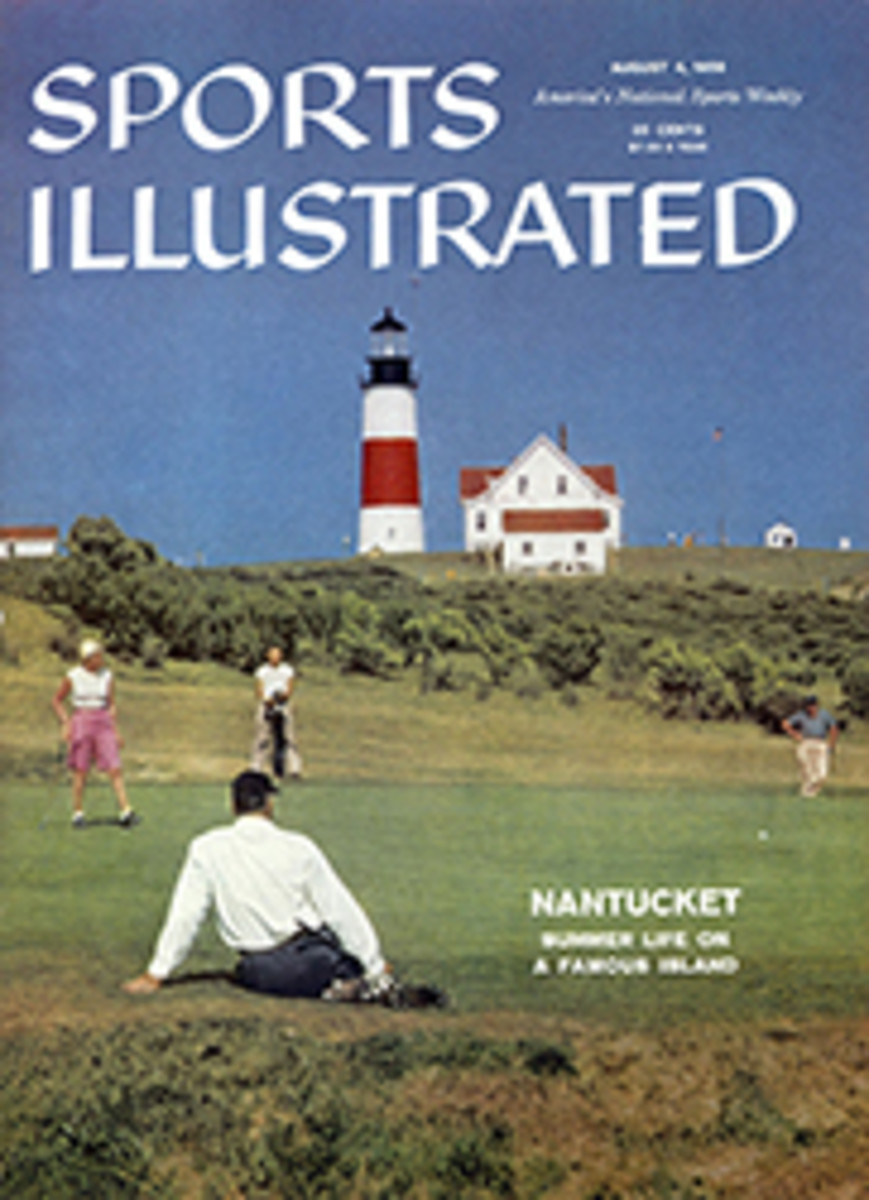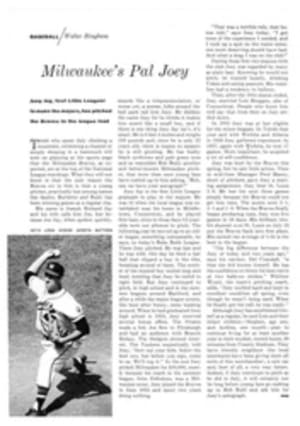
Items from a summer notebook
On all counts but one the recently concluded PGA championship, the first conducted as a 72-hole strokes-play event since the tournament was started back in the year of 19 and 16 (as Sam Snead would say), was immensely successful. From the first day on, when some 8,000 spectators poured onto the Llanerch Country Club course on the edge of Philadelphia, the galleries were large—so large, in fact, that the PGA, finding itself deep in the black, increased the total prize money from the original $30,000 to almost $40,000. The course, which hardly anyone expected would offer much trouble, provided plenty. Though 50 yards wide as a general rule, the fairways were difficult targets, partially because of the winds and partially because many of the players, with good reason, were trying to place their drives on many holes on the side of the fairway which set up the most favorable (and safest) approach to the dangerously small greens. These greens couldn't have averaged much over 3,000 square feet in area and, dried hard by the winds, they were tough to hit and hold. If you missed them, invariably you were left, not with a simple chip but with a worrisome recovery from a trap at the foot of a quick bank or from the beard of rough which fringed the green area tightly, in the style of the USGA and Henry VIII. Not a great championship course, by any means, but a very exacting and touchy proposition, and to play it in consecutive rounds of 67, 72, 70, 67—which the new champion, Dow Finsterwald, did—amounted to control golf of the first order.
Finsterwald's was a very popular victory, for many reasons. Today, when nearly every golf fan is not only a verbal professional-without-portfolio but also a practicing statistician fit to carry the glove of any baseball announcer, it is probably superfluous to report that over the past 31 months Dow has won only one tournament and finished second in no less than 17. Accordingly, it was heartening to see him finally get the girl in the last reel for a change. In addition, Dow is an extremely appealing fellow, soft-spoken, purposeful and with the gift of remaining quite the same whether he is talking shop with a friend or is surrounded on the course by several thousand admirers. He has a good mind, and a mind of his own. Over the past two seasons, to cite the most obvious illustration of this, he has been criticised for playing too conservatively but has not changed his tactics because he has honestly felt, after thinking it over from all sides, that he does not play tournament golf too conservatively. He believes that it may suit other players with different styles and personalities to gamble more than he does but that it is right for him to eschew the sensational tee shot and the spectacular approach shot to the flag and, instead, to work on keeping his stroke production regular and straight and to zero in on the pin only when his instinct tells him it is the move. It is not a bad way to play pressureful medal golf, particularly if you can count on putting well, which Finsterwald certainly can. A fellow by the name of Locke, who has won four British Opens, has always gone about tournament golf with essentially this method and, when you come right down to it, Hogan, while always dynamically ready to charge, frequently left the passing fireworks to the others and built many of his finest performances (such as at Merion in '50) on serene, sensible, steady stroke production from tee to green.
However, there was one thing the 1958 PGA Championship lacked, as we noted earlier, and that it did was inevitable: by changing its format to strokes play it seemed like just another weekly circuit tournament (albeit a good one) and not like the PGA Championship. For four decades (including those recent years when the tourney was permitted to disintegrate), this championship was singular and impressive because it marked the one time in the year when the pros met in match play. Over the past weeks many of my colleagues and other golf fans whose involvement in the game goes back a ways have been recalling the numberless dramatic matches they have witnessed in the championship, such as Sarazen versus Hagen in '23, Hagen versus Diegel in '29, Armour versus Sarazen in '30, Runyan versus Wood in '34 and Snead in '38, Shute against Thomson in '36, Nelson versus Snead in '40, Nelson versus Mike Turnesa in '45, Hogan versus Oliver in '46 and Demaret in '48, Jim Turnesa versus Harbert in '52, Middlecoff versus Burke in '55—to name only a few of the memorable matches which come first to mind. It has been bruited around, not without some design, that one of the reasons why the tournament format had to be changed was that match play is dull for the galleries and strokes play is exciting. This isn't so.
What prompted the change-over in the tournament was the hard economics of the matter: a strokes-play tournament can be counted on to attract larger crowds and return a profit. The chance to see the famous golfers in the flesh is what draws the fans, and in strokes play the presence of the stars is all but assured for the full run of the event, including the Saturday and Sunday when the financial success of a tournament is made or missed. In match play, on the other hand, some name stars will necessarily be eliminated with each ensuing round, and by the time the weekend arrives the real big draws, the incomparable Sam Snead in particular, can have been eliminated. It is not going too far at all to say that having Snead on the premises is in itself enough to insure the success of any tournament. With the one exception of Hogan (who now enters only a handful of events), Snead stands alone in his ability to magnetize a countryside. He is a living legend. People cannot wait to see him. When they do, no matter how high their expectations, they are seldom let down, for he combines all the elements of color. He still possesses the game's most beautiful swing. He is still spectacularly long, and his style of unleashing through the ball makes him seem at least as long as he is. He carries his feelings so readily on his sleeve that a spectator must share in his fortunes and misfortunes. Above and beyond this, he is just plain endowed with a native magnetism to find the likes of which you must go back to the '20s and to Ruth, Dempsey, Tilden and Hagen. Even when Sam is having a bad day and working hard for a 74, he will still collect and hold on to a larger gallery than is following the front-runner, a not uncolorful gent in his own right who is fashioning a round deep in the 60s. Well—in strokes play, you've got Sam. In match play, especially in this present day and age when there are so many accomplished professionals, he may be gone before the weekend, and then where are you?
Since the new-format PGA tournament got off to such an auspicious start at the gate, there is little question but that it will be a fixture for some time to come. I for one am deeply sorry to see this. I do not know to what extent the operation of the PGA, the national organization, depends on its share of the proceeds from its annual tournament, and this is really the critical point. As regards the rest of the picture, professional golf and professional golfers are prospering financially beyond anyone's fondest dreams, and this being the case, I would think that one week of the year the players and their parent organization, out of sheer pride in the game they have done so much for, would be thinking only of putting on for their own gratification the finest and most enjoyable tournament possible, in which the year's champion at their historic type of competition, match play, would be determined. I am not at all certain that such an event would lose money, but I have a feeling that it would take all of a morning to find a sponsor delighted to assume the risk and pick up the tab. As I say, this may be impractical because of the degree of real dependence by the PGA on tangible profits from its annual event, but I am prompted to make these suggestions since many of us felt at Llanerch that professional golf had gained a tournament and lost a championship.
The newest wrinkle in spectator aids was unveiled a few weeks back in the Ladies' PGA event in Minneapolis which modestly assumed the name of the Women's American Open. Not only was the relative standing of each player with par—so many strokes over or under for the round—recorded on the usual portable score standards, but each contender was also accompanied by an auxiliary standard which informed the galleries as to the club she had used on her last shot. The mechanics were simple: after each shot, the bearer of one of these auxiliary standards asked the player's caddie what club she had used or found out for himself by looking in the bag. One hitch had to be overcome, though. At the beginning these second standard-bearers were a little overeager and posted the number of the club even as the player was making her approach or right afterward. This, as you can see, provided very helpful information to her rivals who had driven a bit farther down the fairway and had yet to select the club for their approach. The obvious solution was to withhold posting any of the clubs until all had played "the like" shot—and with this ironed out, everyone was all for the innovation. It has a future.
Judged primarily on their records in the major championships—in the long run, the surest of all indices—the five greatest golfers in the dozen-year span since the end of World War II have been Ben Hogan (4 U.S. Opens, 1 British Open, 2 Masters, 2 PGAs), Sam Snead (1 British Open, 3 Masters, 2 PGAs), Cary Middlecoff (2 U.S. Opens, 1 Masters), Bobby Locke of South Africa (4 British Opens) and Peter Thomson of Australia (4 British Opens). With his most recent victory in the British this July, Peter Thomson, who at 28 is by far the youngest of the five, extended what surely must be the most astounding record for consecutive performance ever compiled by any modern golfer in any major championship. It would do, of course, to state that in seven straight British Opens Thomson has never finished lower than second, but to set it out in a chart would be more impressive and that is the least we can do:
PHOTO
PETER THOMSON AND AN OLD FRIEND
Year | Course | Thomson |
1952 | Lytham | 2nd |
1953 | Carnoustie | tied 2nd |
1954 | Birkdale | 1st |
1955 | St. Andrews | 1st |
1956 | Hoylake | 1st |
1957 | St. Andrews | 2nd |
1958 | Lytham | 1st |

